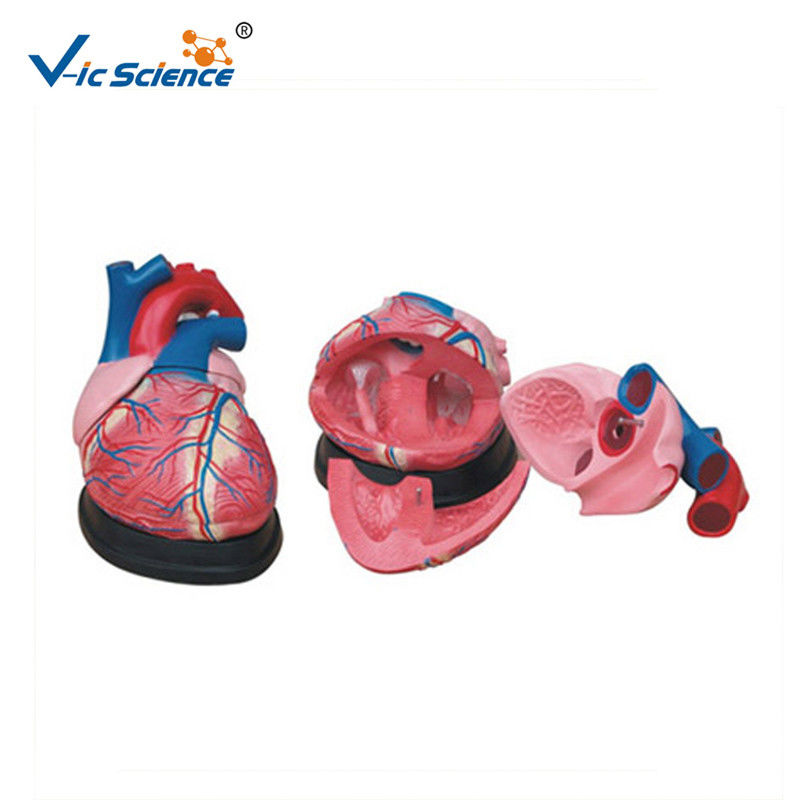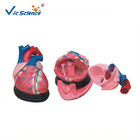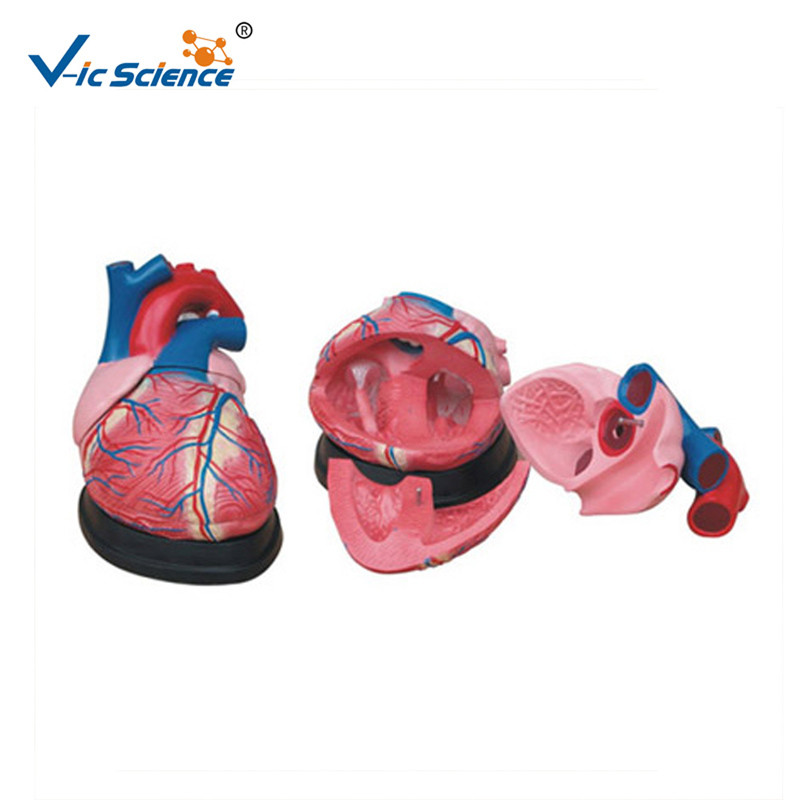|
हृदय ज्ञान के बारे में
The heart is a muscular organ in most animals, which pumps blood through the blood vessels of the circulatory system. दिल ज्यादातर जानवरों में एक पेशी अंग है, जो रक्त परिसंचरण तंत्र के रक्त वाहिकाओं के माध्यम से रक्त पंप करता है। Blood provides the body with oxygen and nutrients, as well as assisting in the removal of metabolic wastes. रक्त शरीर को ऑक्सीजन और पोषक तत्व प्रदान करता है, साथ ही साथ चयापचय अपशिष्टों को हटाने में सहायता करता है। In humans, the heart is located between the lungs, in the middle compartment of the chest. मनुष्यों में, हृदय फेफड़ों के बीच, छाती के मध्य डिब्बे में स्थित होता है।
In humans, other mammals, and birds, the heart is divided into four chambers: upper left and right atria and lower left and right ventricles.Commonly the right atrium and ventricle are referred together as the right heart and their left counterparts as the left heart. मनुष्यों, अन्य स्तनधारियों और पक्षियों में, हृदय को चार कक्षों में विभाजित किया जाता है: ऊपरी बाएं और दाएं अटरिया और निचले बाएं और दाएं निलय। सही तरीके से आलिंद और निलय को एक साथ दाहिने हृदय और बाएं हृदय के रूप में उनके बाएं समकक्षों के रूप में संदर्भित किया जाता है। । Fish, in contrast, have two chambers, an atrium and a ventricle, while reptiles have three chambers. मछली, इसके विपरीत, दो कक्ष, एक अलिंद और एक निलय है, जबकि सरीसृप में तीन कक्ष हैं। In a healthy heart blood flows one way through the heart due to heart valves, which prevent backflow. एक स्वस्थ हृदय में रक्त हृदय वाल्वों के कारण हृदय के माध्यम से एक तरह से बहता है, जो बैकफ़्लो को रोकता है। The heart is enclosed in a protective sac, the pericardium, which also contains a small amount of fluid. दिल एक सुरक्षात्मक थैली में संलग्न है, पेरिकार्डियम, जिसमें द्रव की एक छोटी मात्रा भी होती है। The wall of the heart is made up of three layers: epicardium, myocardium, and endocardium. हृदय की दीवार तीन परतों से बनी है: एपिकार्डियम, मायोकार्डियम और एंडोकार्डियम।
The heart pumps blood with a rhythm determined by a group of pacemaking cells in the sinoatrial node. हृदय रक्त को पंप करता है जिसमें सिनोनाट्रियल नोड में पेसमेकिंग कोशिकाओं के एक समूह द्वारा निर्धारित किया जाता है। These generate a current that causes contraction of the heart, traveling through the atrioventricular node and along the conduction system of the heart. ये एक धारा उत्पन्न करते हैं जो हृदय के संकुचन का कारण बनता है, एट्रियोवेंट्रिकुलर नोड के माध्यम से और दिल की चालन प्रणाली के साथ यात्रा करता है। The heart receives blood low in oxygen from the systemic circulation, which enters the right atrium from the superior and inferior venae cavae and passes to the right ventricle. प्रणालीगत परिसंचरण से दिल को ऑक्सीजन में रक्त कम मिलता है, जो कि बेहतर और अवर वेना केवा से सही एट्रियम में प्रवेश करता है और दाएं वेंट्रिकल से गुजरता है। From here it is pumped into the pulmonary circulation, through the lungs where it receives oxygen and gives off carbon dioxide. यहाँ से इसे फेफड़े के परिसंचरण में फेफड़ों के माध्यम से पंप किया जाता है, जहाँ यह ऑक्सीजन प्राप्त करता है और कार्बन डाइऑक्साइड को छोड़ देता है। Oxygenated blood then returns to the left atrium, passes through the left ventricle and is pumped out through the aorta to the systemic circulation−where the oxygen is used and metabolized to carbon dioxide. ऑक्सीजन युक्त रक्त फिर बाएं आलिंद में लौटता है, बाएं वेंट्रिकल से गुजरता है और महाधमनी के माध्यम से प्रणालीगत संचलन के लिए बाहर पंप किया जाता है the जहां ऑक्सीजन का उपयोग किया जाता है और कार्बन डाइऑक्साइड के लिए चयापचय होता है। The heart beats at a resting rate close to 72 beats per minute. दिल एक आराम की दर पर धड़कता है जो प्रति मिनट 72 बीट के करीब है। Exercise temporarily increases the rate, but lowers resting heart rate in the long term, and is good for heart health. व्यायाम अस्थायी रूप से दर को बढ़ाता है, लेकिन लंबी अवधि में हृदय गति को आराम देता है, और हृदय स्वास्थ्य के लिए अच्छा है।

संरचना
The human heart is situated in the middle mediastinum, at the level of thoracic vertebrae T5-T8. मानव हृदय मध्य मीडियास्टीनम में स्थित है, वक्ष कशेरुका T5-T8 के स्तर पर। A double-membraned sac called the pericardium surrounds the heart and attaches to the mediastinum. एक डबल झिल्लीदार थैली जिसे पेरीकार्डियम कहा जाता है, हृदय को घेर लेती है और मीडियास्टीनम से जुड़ जाती है। The back surface of the heart lies near the vertebral column, and the front surface sits behind the sternum and rib cartilages. दिल की पिछली सतह कशेरुक स्तंभ के पास होती है, और सामने की सतह उरोस्थि और रिब उपास्थि के पीछे बैठती है। The upper part of the heart is the attachment point for several large blood vessels—the venae cavae, aorta and pulmonary trunk. दिल का ऊपरी हिस्सा कई बड़ी रक्त वाहिकाओं के लिए लगाव बिंदु है - वेना कावा, महाधमनी और फुफ्फुसीय ट्रंक। The upper part of the heart is located at the level of the third costal cartilage. दिल का ऊपरी हिस्सा तीसरी कॉस्टल उपास्थि के स्तर पर स्थित है। The lower tip of the heart, the apex, lies to the left of the sternum (8 to 9 cm from the midsternal line) between the junction of the fourth and fifth ribs near their articulation with the costal cartilages. दिल का निचला सिरा, शीर्ष, चौकोर और पांचवीं पसलियों के जंक्शन के बीच उरोस्थि (8 से 9 सेंटीमीटर मध्य रेखा से बाईं ओर) में उनके कार्टिलेज के साथ कॉस्टल उपास्थि के साथ स्थित होता है।
The largest part of the heart is usually slightly offset to the left side of the chest (though occasionally it may be offset to the right) and is felt to be on the left because the left heart is stronger and larger, since it pumps to all body parts. दिल का सबसे बड़ा हिस्सा आम तौर पर छाती के बाईं ओर थोड़ा ऑफसेट होता है (हालांकि कभी-कभी इसे दाएं से ऑफसेट किया जा सकता है) और बाईं ओर महसूस किया जाता है क्योंकि बाएं दिल मजबूत और बड़ा होता है, क्योंकि यह सभी को पंप करता है शरीर के अंग। Because the heart is between the lungs, the left lung is smaller than the right lung and has a cardiac notch in its border to accommodate the heart. क्योंकि हृदय फेफड़ों के बीच होता है, बायाँ फेफड़ा दाहिने फेफड़े की तुलना में छोटा होता है और हृदय को समायोजित करने के लिए इसकी सीमा में कार्डियक पायदान होता है। The heart is cone-shaped, with its base positioned upwards and tapering down to the apex. दिल शंकु के आकार का है, जिसका आधार ऊपर की ओर स्थित है और शीर्ष तक नीचे जाता है। An adult heart has a mass of 250–350 grams (9–12 oz). एक वयस्क दिल का द्रव्यमान 250-350 ग्राम (9–12 औंस) होता है। The heart is often described as the size of a fist: 12 cm (5 in) in length, 8 cm (3.5 in) wide, and 6 cm (2.5 in) in thickness, although this description is disputed, as the heart is likely to be slightly larger. दिल को अक्सर मुट्ठी के आकार के रूप में वर्णित किया जाता है: लंबाई में 12 सेमी (5 इंच), 8 सेमी (3.5 इंच) चौड़ा, और मोटाई में 6 सेमी (2.5 इंच), हालांकि यह विवरण विवादित है, जैसा कि दिल की संभावना है थोड़ा बड़ा होना। Well-trained athletes can have much larger hearts due to the effects of exercise on the heart muscle, similar to the response of skeletal muscle. अच्छी तरह से प्रशिक्षित एथलीटों में कंकाल की मांसपेशियों की प्रतिक्रिया के समान हृदय की मांसपेशियों पर व्यायाम के प्रभाव के कारण बहुत बड़े दिल हो सकते हैं।
|
 आपका संदेश 20-3,000 अक्षरों के बीच होना चाहिए!
आपका संदेश 20-3,000 अक्षरों के बीच होना चाहिए! कृपया अपनी ईमेल देखें!
कृपया अपनी ईमेल देखें!  आपका संदेश 20-3,000 अक्षरों के बीच होना चाहिए!
आपका संदेश 20-3,000 अक्षरों के बीच होना चाहिए! कृपया अपनी ईमेल देखें!
कृपया अपनी ईमेल देखें!


